
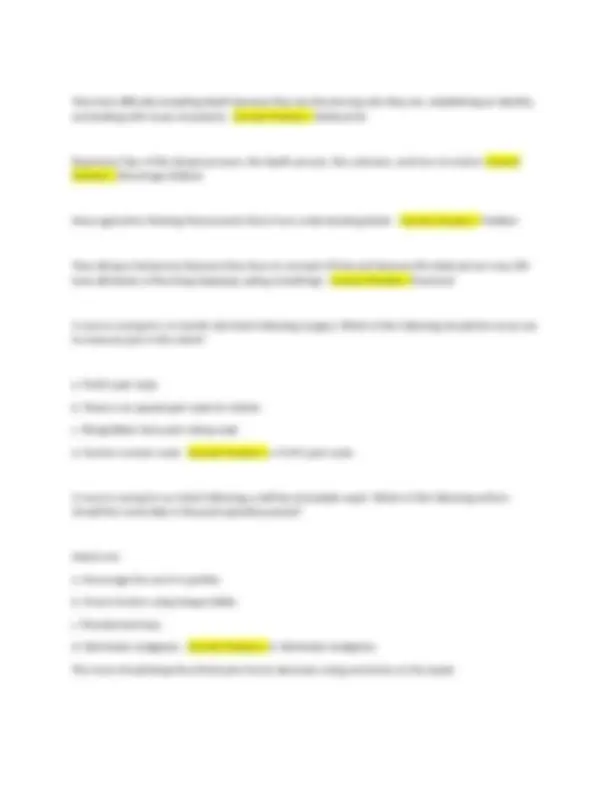
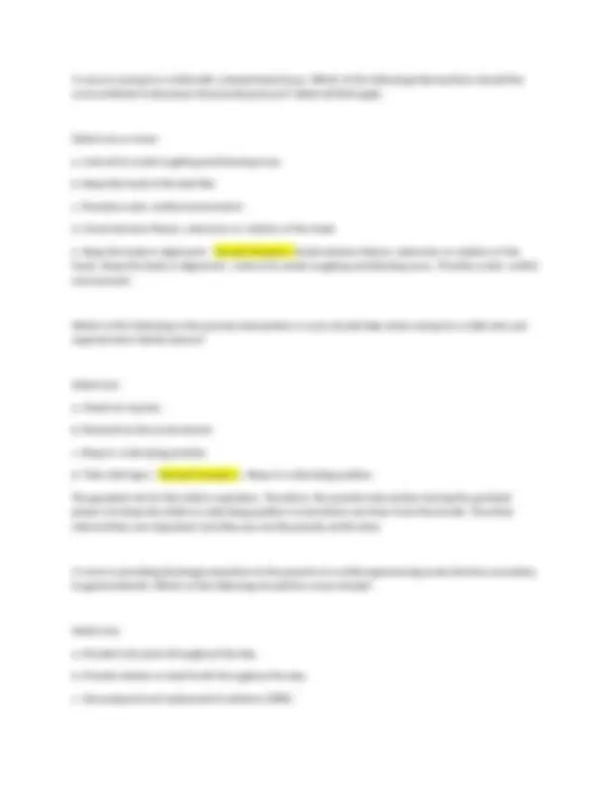
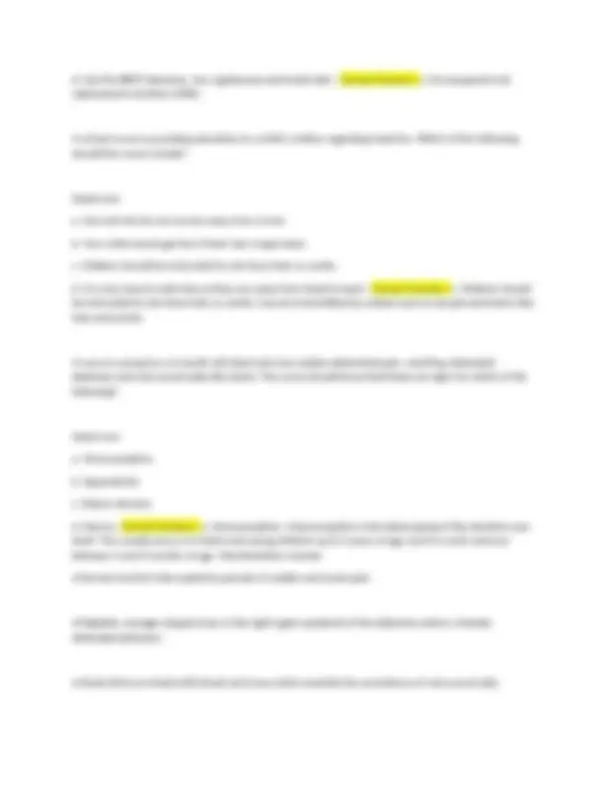
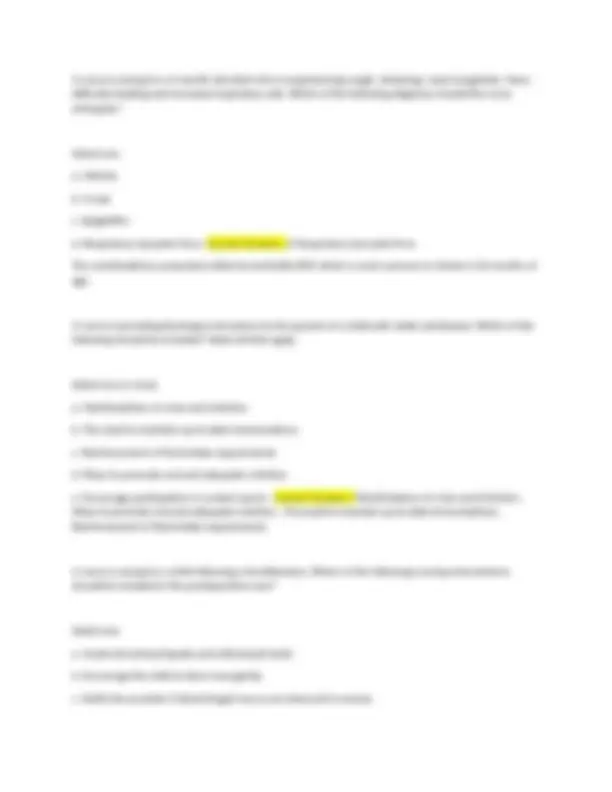
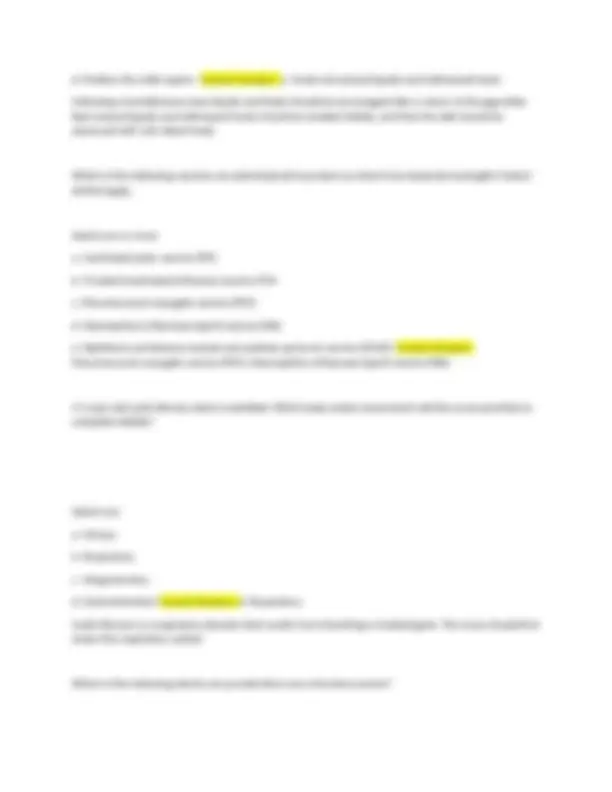
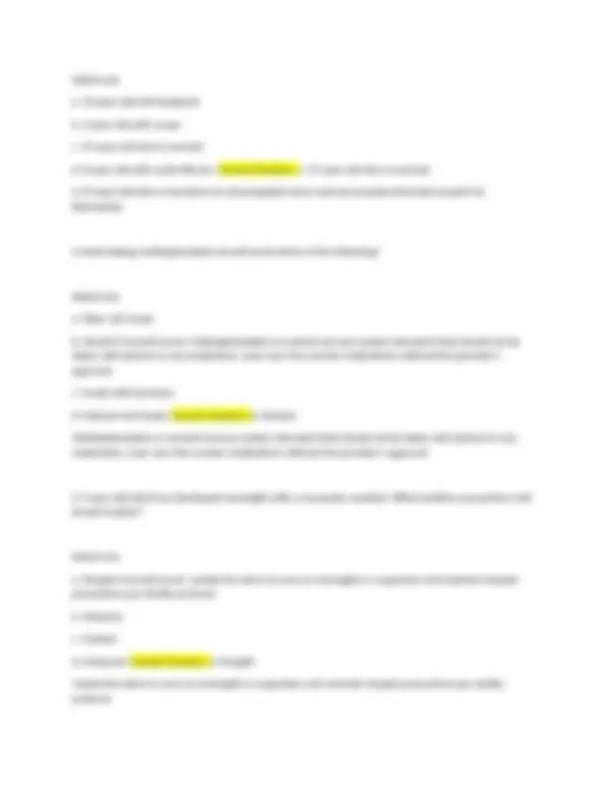
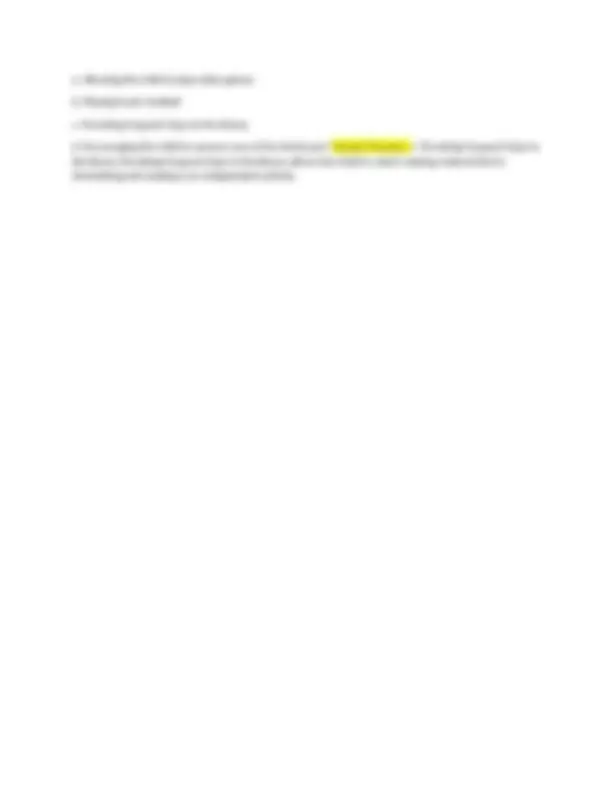


Study with the several resources on Docsity

Earn points by helping other students or get them with a premium plan


Prepare for your exams
Study with the several resources on Docsity

Earn points to download
Earn points by helping other students or get them with a premium plan
Community
Ask the community for help and clear up your study doubts
Discover the best universities in your country according to Docsity users
Free resources
Download our free guides on studying techniques, anxiety management strategies, and thesis advice from Docsity tutors
A series of questions and answers related to nursing care of children, covering topics such as developmental milestones, common childhood illnesses, and post-operative care. It is a valuable resource for students and professionals in the field of nursing, offering insights into the assessment and management of pediatric patients.
Typology: Exams
1 / 13

This page cannot be seen from the preview
Don't miss anything!








[COMPANY NAME] [Company address]
Drawing, painting, riding a tricycle -Correct Answers: preschoolers Banging large block -Correct Answers: 9 - 12 months Team sports -Correct Answers: school-aged Watching black-and-white mobiles -Correct Answers: Birth to 3 months Playing peek-a-boo -Correct Answers: 6 to 9 months Holding a soft rattle -Correct Answers: 3 to 6 months Loud, harsh murmur; Mild heart failure; Possible enlarged right atrium; Increased oxygen saturations in the right atrium; Asymptomatic (possibly). -Correct Answers: Atrial septal defect (ASD) Increased blood pressure and oxygen saturation in the upper extremities compared to the lower extremities; Nosebleeds; Headaches, vertigo, leg pain, weak or absent lower extremity pulses (indicate decreased cardiac output). -Correct Answers: Coarctation of the aorta Murmur (machine-hum); Wide pulse pressure; Bounding pulses; Asymptomatic (possibly) -Correct Answers: Patent ductus arteriosus (PDA) Systolic ejection murmur; Right ventricular enlargement; Exercise intolerance; Cyanosis with severe narrowing. -Correct Answers: Pulmonary stenosis Loud, harsh murmur that is not usually audible until pulmonary pressures drop at about 4 to 8 weeks of age; Heart failure; Failure to thrive; Small, possibly asymptomatic defects. -Correct Answers: Ventricular septal defect (VSD) Murmur; Cyanosis, severe dyspnea, clubbing of the fingers, hypercyanotic spells, and acidosis; Polycythemia, clot formation; Frequently sits in a squatting position (decreases venous return); Failure to thrive and growth retardation -Correct Answers: Tetralogy of Fallot
A nurse is caring for a child with a closed head injury. Which of the following interventions should the nurse institute to decrease intracranial pressure? Select all that apply. Select one or more: a. Instruct to avoid coughing and blowing nose. b. Keep the head of the bed flat. c. Provide a calm, restful environment. d. Avoid extreme flexion, extension or rotation of the head. e. Keep the body in alignment. -Correct Answers: Avoid extreme flexion, extension or rotation of the head., Keep the body in alignment., Instruct to avoid coughing and blowing nose., Provide a calm, restful environment. Which of the following is the priority intervention a nurse should take when caring for a child who just experienced a febrile seizure? Select one: a. Check for injuries. b. Reorient to the environment. c. Keep in a side-lying position. d. Take vital signs. -Correct Answers: c. Keep in a side-lying position. The greatest risk for the child is aspiration. Therefore, the priority intervention during the postictal phase is to keep the child in a side-lying position so secretions can drain from the mouth. The other interventions are important, but they are not the priority at this time. A nurse is providing discharge education to the parents of a child experiencing acute diarrhea secondary to gastroenteritis. Which of the following should the nurse include? Select one: a. Provide fruit juices throughout the day. b. Provide chicken or beef broth throughout the day. c. Use prepared oral replacement solutions (ORS).
d. Use the BRAT (bananas, rice, applesauce and toast) diet. -Correct Answers: c. Use prepared oral replacement solutions (ORS). A school nurse is providing education to a child's mother regarding head lice. Which of the following should the nurse include? Select one: a. Lice and nits do not survive away from a host. b. Your child cannot get lice if their hair is kept clean. c. Children should be instructed to not share hats or combs. d. It is very easy to catch lice as they can jump from head to head. -Correct Answers: c. Children should be instructed to not share hats or combs. Lice are transmitted by contact such as via personal items like hats and combs. A nurse is caring for a 6-month-old client who has sudden abdominal pain, vomiting, distended abdomen and red current jelly-like stools. The nurse should know that these are signs for which of the following? Select one: a. Intussusception. b. Appendicitis. c. Pyloric stenosis. d. Hernia. -Correct Answers: a. Intussusception. Intussusception is the telescoping of the intestine over itself. This usually occurs in infants and young children up to 5 years of age, but it is most common between 5 and 9 months of age. Manifestations include:
e. Solids can be introduced between 4 and 6 months of age. -Correct Answers: a, c, d, e - Solids can be introduced between 4 and 6 months of age., Iron-fortified rice cereal should be offered first., New foods should be introduced one at a time over a 5- to 7-day period to observe for signs of allergies or intolerance., Vegetables or fruits are first started between 6 and 8 months of age. After both have been introduced, meats can be added. A nurse is providing developmental education to the mother of a 2-year-old child. What information regarding temper tantrums should the nurse include? Select one: a. This indicates a type of learning disability. b. A psychological consult is needed. c. Give the child whatever they want to prevent tantrums. d. This is a child's way of trying to gain control and power. -Correct Answers: d. This is a child's way of trying to gain control and power. Temper tantrums are common during the toddler years because at this age the child becomes easily frustrated with restrictions on independence. Providing consistent, age-appropriate expectations helps toddlers to work through frustration. What manifestations should the nurse anticipate for the client with rheumatic fever? Select all that apply. Select one or more: a. CNS involvement (chorea) including involuntary, purposeless muscle movements b. Nontender, subcutaneous nodules over bony prominences c. Pink, nonpruritic macular rash on the trunk and inner surfaces of extremities d. A negative serum antistreptolysin-O (ASO) titer e. Muffled heart sounds, pericardial friction rub, and reports of chest pain -Correct Answers: Nontender, subcutaneous nodules over bony prominences, Pink, nonpruritic macular rash on the trunk and inner surfaces of extremities, CNS involvement (chorea) including involuntary, purposeless muscle movements, Muffled heart sounds, pericardial friction rub, and reports of chest pain
A nurse is caring for a 2-month-old client who is experiencing cough, wheezing, nasal congestion, fever, difficulty feeding and increased respiratory rate. Which of the following diagnosis should the nurse anticipate? Select one: a. Asthma b. Croup c. Epiglottitis d. Respiratory Syncytial Virus -Correct Answers: d. Respiratory Syncytial Virus The manifestations presented reflect bronchiolitis/RSV which is most common in infants 2-12 months of age. A nurse is providing discharge instructions to the parents of a child with sickle cell disease. Which of the following should be included? Select all that apply. Select one or more: a. Manifestations of crisis and infection. b. The need to maintain up-to-date immunizations. c. Reinforcement of fluid intake requirements. d. Ways to promote rest and adequate nutrition. e. Encourage participation in contact sports. -Correct Answers: Manifestations of crisis and infection., Ways to promote rest and adequate nutrition., The need to maintain up-to-date immunizations., Reinforcement of fluid intake requirements. A nurse is caring for a child following a tonsillectomy. Which of the following nursing interventions should be included in the postoperative care? Select one: a. Avoid red-colored liquids and milk-based foods. b. Encourage the child to blow nose gently. c. Notify the provider if blood-tinged mucus are observed in emesis.
Select one: a. 12-year-old with leukemia b. 4-year-old with croup c. 17-year-old who is married d. 8-year-old with cystic fibrosis -Correct Answers: c. 17-year-old who is married. A 17-year-old who is married is an emancipated minor and can provide informed consent for themselves. A client taking methylphenidate should avoid which of the following? Select one: a. Fiber-rich foods b. Alcohol CorrectCorrect. Methylphenidate is a central nervous system stimulant that should not be taken with alcohol or any medication, even over the counter medications without the provider's approval. c. Foods with tyramine d. Calcium-rich foods -Correct Answers: b. Alcohol Methylphenidate is a central nervous system stimulant that should not be taken with alcohol or any medication, even over the counter medications without the provider's approval. A 7-year-old client has developed meningitis after a traumatic accident. What isolation precautions will be put in place? Select one: a. Droplet CorrectCorrect. Isolate the client as soon as meningitis is suspected, and maintain droplet precautions per facility protocol. b. Airborne c. Contact d. Universal -Correct Answers: a. Droplet Isolate the client as soon as meningitis is suspected, and maintain droplet precautions per facility protocol.
Which injury prevention measure for poisoning will help preserve home safety recommendation? Select one: a. A working carbon monoxide detector should be kept in the home. b. Anchor heavy objects and furniture so they cannot be overturned. c. Secure fence around pool. d. The temperature of the bath should be assessed. -Correct Answers: a. A working carbon monoxide detector should be kept in the home. To preserve home safety it is important to have a working carbon monoxide detector in the home. A client with osteomyelitis has severe pain. Which medication, administered by the nurse is most appropriate to manage pain? Select one: a. Sumatriptan b. Acetaminophen c. Morphine d. Methotrexate -Correct Answers: c. Morphine Morphine is used for severe pain associated with osteomyelitis. Acetaminophin is used for mild pain. Methotrexate is primary used for autoimmune conditions to stop the progression of the autoimmune process. Sumatriptan is a serotonin receptor agonist that helps with migraine headache pain. A 7-month-old is admitted for suspected shaken baby syndrome. Which nursing action is most appropriate? Select one: a. Assist client with maintaining self-image. b. Document assessment information objectively. c. Maintain low continuous suction.
a. Allowing the child to play video games b. Playing touch football c. Providing frequent trips to the library d. Encouraging the child to assume care of the family pet -Correct Answers: c. Providing frequent trips to the library Providing frequent trips to the library allows the child to select reading material that is stimulating and reading is an independent activity.